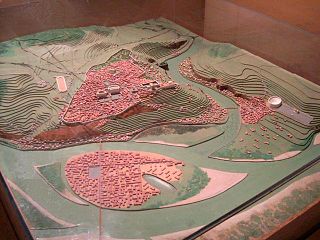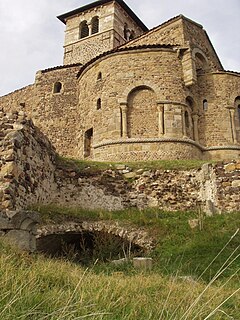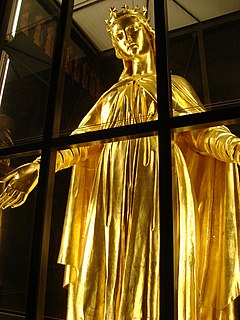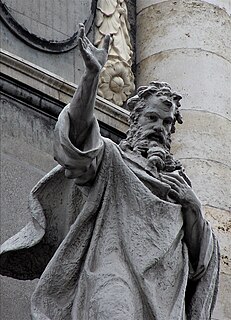
Colonia Copia Claudia Augusta Lugdunum was an important Roman city in Gaul, established on the current site of Lyon. The city was founded in 43 BC by Lucius Munatius Plancus. It served as the capital of the Roman province of Gallia Lugdunensis and was an important city in the western half of the Roman Empire for centuries. Two emperors, Claudius and Caracalla, were born in Lugdunum. In the period AD 69–192 the city's population may have numbered 50,000 to 100,000, and possibly up to 200,000 inhabitants.

Saint-Romain-le-Puy is a commune in the Loire department in central France.

Saint-Bertrand-de-Comminges is a commune (municipality) and former episcopal see in the Haute-Garonne department in southwestern France. It is a member of the Les Plus Beaux Villages de France association.

Fourvière is a district of Lyon, France, a hill immediately west of the old part of the town, rising from the river Saône.

The persecution in Lyon in AD 177 was a persecution of Christians in Lugdunum, Roman Gaul, during the reign of Marcus Aurelius (161-180). An account of this persecution is a letter preserved in Eusebius's Ecclesiastical History, book 5, chapter 1. Gregory of Tours describes the persecution in De Gloria martyrum.

Lyon or Lyons is the third-largest city and second-largest urban area of France. It is located at the confluence of the rivers Rhône and Saône, about 470 km (292 mi) south-east of Paris, 320 km (199 mi) north of Marseille and 56 km (35 mi) northeast of Saint-Étienne. Inhabitants of the city are called Lyonnais.

Ajat is a commune in the Dordogne department in Nouvelle-Aquitaine in southwestern France.

Craponne is a commune in the Metropolis of Lyon in the Auvergne-Rhône-Alpes region in eastern France.

The Amphitheatre of the Three Gauls of Lugdunum (Lyon) was part of the Sanctuary of the Three Gauls dedicated to the cult of Rome and Augustus celebrated by the 60 Gallic tribes when they gathered at Lugdunum. In 1961, it was classified as a monument historique.

The Museum of Fine Arts of Lyon is a municipal museum of fine arts in the French city of Lyon. Located near Place des Terreaux, it is housed in a former Benedictine convent which was active during the 17th and 18th centuries. It was restored between 1988 and 1998, remaining open to visitors throughout this time despite the restoration works. Its collections range from ancient Egyptian antiquities to the Modern art period, making the museum one of the most important in Europe. It also hosts important exhibitions of art, for example the exhibitions of works by Georges Braque and Henri Laurens in the second half of 2005, and another on the work of Théodore Géricault from April to July 2006. It is one of the largest art museums in France.

The term "Gallo-Roman" describes the Romanized culture of Gaul under the rule of the Roman Empire. This was characterized by the Gaulish adoption or adaptation of Roman culture, language, morals and way of life in a uniquely Gaulish context. The well-studied meld of cultures in Gaul gives historians a model against which to compare and contrast parallel developments of Romanization in other, less-studied Roman provinces.

Lyon is a city in the south of France. The area has been inhabited since prehistoric times and was one of the most important cities of the Roman Empire, Lugdunum. After the Battle of Lugdunum (197) the city never fully recovered, and Lyon was built out of its ashes becoming a part of the Kingdom of the Burgundians.

The 5th arrondissement of Lyon is one of the nine arrondissements of the City of Lyon.

Lugdunum, formerly known as the Gallo-Roman Museum of Lyon-Fourvière, is a museum of Gallo-Roman civilisation in Lyon. Previously presented at the Museum of Fine Arts of Lyon and the Antiquarium, the municipal Gallo-Roman collection was transferred to a new building designed by Bernard Zehrfuss and opened in 1975 near the city's Roman theatre and odeon, on a hill known as Fourvière, located in the heart of the Roman city. Internally, it is formed of a concrete spiral ramp descending and branching out into the display rooms. It is managed and operated by the Metropolis of Lyon jointly with the archaeological museum of Saint-Romain-en-Gal. As well as displaying its own permanent collections of Roman, Celtic and pre-Roman material, a plan-relief of the ancient town and scale models of its major monuments such as the theatre and the Odeon, it also regularly hosts temporary exhibitions.

The Taurobolic Altar is an inscribed ancient Roman altar found in 1704 in a vineyard belonging to a certain Bourgeat on the Fourvière hill in Lyon, France. It dates to the year 160 and refers to a taurobolium carried out in Lugdunum to Cybele for the restoration of the emperor Antoninus Pius's health. It is now held at the Gallo-Roman Museum of Lyon.

The Sanctuary of the Three Gauls (Tres Galliae) was the focal structure within an administrative and religious complex established by Rome in the very late 1st century BC at Lugdunum. Its institution served to federalise and Romanise Gallia Comata as an Imperial province under Augustus, following the Gallic Wars of his predecessor Julius Caesar. The distinctively Gallo-Roman development of the Imperial sanctuary and its surrounding complex are well attested by literary, epigraphic, numismatic and archaeological evidence.
The "Courrier de Lyon" case is a famous French criminal case. It occurred during the French Revolution. During the night of 27 and 28 April 1796, a mail coach was ambushed outside Paris by several men who stole a large sum of money. The stage coach was supposed to go to Lyon from Paris, carrying money for the Army of Italy. Both the driver and the armed guard were brutally killed. A third man on board, travelling under an assumed name, participated in the killing and later vanished.
Amable Audin (1899–1990) was a French archaeologist. He specialized in studying the Roman city of Lugdunum, known in modern times as Lyon, France.

The Basilica of Saint-Just also known as Saint-Just basilica or the Maccabees Basilica was one of the oldest and most powerful churches in the city of Lyon until it was destroyed during the French Wars of Religion.

The Primate of the Gauls is a title given since 1079 to the archbishop of Lyon, former capital of the Three Gauls then land of the Roman Empire, and has described the authority he has exercised in the past over the other bishops of France. The primacy of a title conferred on Archbishop guarantees a theoretical jurisdiction over several ecclesiastical provinces. In France, only the title of Primate of the Gauls and Primate of Normandy, respectively assigned to the archbishops of Lyon and Rouen, are still used.

















